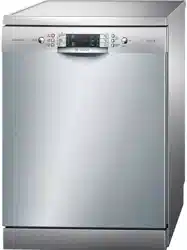Documents: Go to download!
User Manual
- Owner's manual - (English)
- Bosch SMS68M38AU Serie 6 Freestanding Dishwasher Specifications Sheet - (English)
- Safety instructions Safety instruction
- Control panel
- Rinse aid Rinse aid
- Utensils
- Detergent
- Overview of programmes
- Additional options
- Operating the appliance
- Cleaning and maintenance
- Fault, what to do?
- Fault table
Table of contents
User Gudie Bosch SMS68M38AU Dishwasher
Safety instructions Safety instruction
Before you switch ON the appliance
- Please read the operating and installation instructions carefully. They contain important information on how to install, use and maintain the appliance.
- Retain all documents for subsequent use or for the next owner.
Installation
- Following installation, ensure that the back of the dishwasher is not freely accessible (protection against contact due to hot surface).
- Install and connect the appliance according to the installation and assembly instructions.
- Prior to installation, disconnect the dishwasher from the power supply.
- Ensure that the protective conductor system of the domestic supply has been correctly installed.
- The electrical connection conditions must correspond with the specifications on the dishwasher rating plate 92.
- If the power cord of this appliance is damaged, it must be replaced with a particular power cord.
- To prevent injury, the power cord may be purchased from customer service only.
- If the dishwasher is installed in a high-sided unit, the unit must be secured properly.
- If the dishwasher is installed below or above other domestic appliances, follow the information for installation in combination with a dishwasher in the installation instructions for the particular appliances.
- Also follow the installation instructions for the dishwasher to ensure that all appliances are operated safely.
- If there is no information or if the installation instructions do not include the appropriate information, contact the manufacturer of these appliances to ensure that the dishwasher can be installed above or below these appliances. aus Safety instructions
- If you cannot obtain any information from the manufacturer, you must not install the dishwasher above or below these appliances.
- If you install a microwave oven above the dishwasher, the microwave oven may be damaged.
- Install built-under or integratable appliances only under continuous worktops which have been screwed to adjacent cupboards to ensure stability.
- Do not install the appliance near heat sources (radiators, heat storage tanks, cookers or other appliances which generate heat) and do not install under a hob.
- After installing the appliance, ensure that the plug is easily accessible.
Some models:
- The plastic housing on the water connection contains an electric valve, the connecting cables are in the supply hose.
- Do not cut through this hose, do not immerse the plastic housing in water.
In daily use
- Read and observe the safety information and instructions for use on the packaging for cleaning and rinsing agents.
- Childproof lock (door lock)Door lock *
- The description of the childproof lock is at the back in the envelope. depending on model
- Childproof lock (button lock)Button lock You can secure your appliance from being unintentionally the programme terminated (e.g. improper operation by children).
- Activating the button lock:
- Start the required programme.
- Hold down the button + for approx. 4 sec. until this ’– is indicated on the digital display.
- If any button is pressed while the programme is running, this ’– is indicated on the digital display. It is not possible to end (Reset) the programme.
Control panel
- ON/OFF switch
- Programme buttons **
- Display
- “Check water supply”
- Rinse aid refill indicator
- Door opener
- Timer programming *
- Additional options ** `START button
- Programme sequence indicator
- " Digital display
Rinse aid Rinse aid
- As soon as the rinse-aid refill indicator @ is lit on the fascia, there is still a rinse-aid reserve of 1-2 rinsing processes.
- Refill with rinse aid. The rinse aid is required for stain-free utensils and clear glasses. Use only rinse aid for domestic dishwashers.
- Combined detergents with rinse-aid component may be used up to a water hardness of 21° dH (37° fH, 26° Clarke, 3.7 mmol/l) only. If the water hardness is over 21° dH, rinse aid must be used. 1. Open the dispenser by pressig and liftng the plate on the cover. 2. Carefully pour rinse aid up to the max. mark in the filler opening.
Setting amount of rinse aid
- The amount of rinse aid can be set from to Please set rinse aid on to obtain very good drying results is already set in factory).
- Change this setting, only if streaks select lower setting) or water stains select higher setting) are left on the utensils.
- Close the door.
Switch on ON/OFF switch
- Hold down programme button # and press START button ` until is indicated on the digital display.
- Release both buttons.
- Press programme button # until the factory set value §:‹† is indicated on the digital display )".
- To change the setting:
- Press programme button 3.
- Each time the button is pressed, the set value increases by one level; when the value of §:‹‡ has been reached, the display jumps back to §:‹‹ (off).
Press START button `.
- The set value is saved.
- Switching off rinse aid refill indicator
- If the rinse-aid refill indicator @ is impaired (e.g. when using combined detergents containing rinse aid component), it can be switched off.
- Proceed as described under “Setting amount of rinse aid” and set the value to §:‹‹.
- The rinse aid refill indicator @ is now switched off.
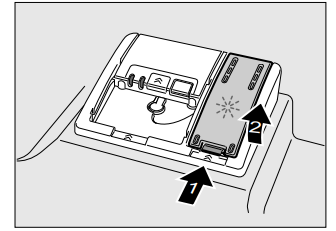
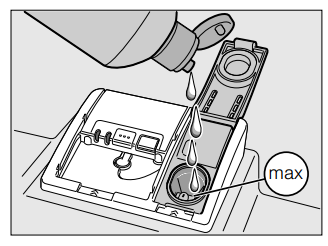
Utensils
Not suitable
- Cutlery and utensils made of wood.
- Delicate decorative glasses, craft and antique utensils. These decors are not dishwasher-proof.
- Plastic parts not resistant to heat.
- Copper and tin utensils.
- Utensils which are soiled with ash, wax, lubricating grease or ink.
- Aluminium and silver parts have a tendency to discolour and fade during the wash cycle. Even some types of glass (e.g. crystal glass objects) may turn cloudy after many wash cycles.
- Glass and utensil damage
Causes:
- Glass type and glass production process.
- Chemical composition of the detergent.
- Water temperature of the wash programme. aus Utensils
Recommendation:
- Use only glasses and porcelain which the manufacturer designates as dishwasher-proof.
- Use a detergent which protects utensils.
- Take glass and cutlery out of the dishwasher as soon as possible after the programme ends.
Loading the dishwasher
- Remove large food remnants. It is not necessary to prerinse utensils under running water.
- Place the utensils so that they are secure and cannot tip over. all utensils with their openings face down. parts with curves or indentations are at an angle, thereby allowing water to drain. does not obstruct rotation of the two spray arms 1: and 1J.
- Very small utensils should not be washed in the machine, as they may fall out of the baskets.
Unloading the dishwasher
- To prevent water from dripping off the upper basket onto the utensils in the lower basket, it is recommended to empty the appliance from the bottom up.
- Hot utensils are sensitive to shock!
- Therefore, when the programme ends, leave the utensils to cool down in the dishwasher until they can be handled.
Cups and glasse

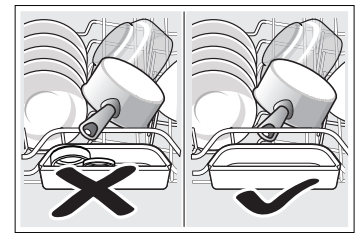
Utlery basket
- You should always place cutlery unsorted with the points downwards.
- To prevent injuries, place long, pointed implements and knives on the knife shelf.
- Cutlery drawer
- Arrange the cutlery in the cutlery drawer as illustrated. Separately arranged utensils are easier to remove after washing.
The drawer can be taken out.
- Folding spikes * depending on model
- The spikes can be folded down to improve arrangement of pans, bowls and glasses.
- Small accessories holder *Small accessories holder depending on model
- Light-weight plastic accessories, e.g. cups, lids, etc. can be held securely in the small accessories holder.
- Adjusting the height of the basket
- The height of the upper utensils basket can be adjusted in 3 stages to create more space either in the upper or lower basket.
Pull out the top basket 12 out.
- To lower the basket, press in the left and then the right lever on the outside of the basket. In doing so, hold the sides of the basket along the upper edge to prevent it from suddenly dropping.
- To raise the basket, hold the basket on the sides of the upper edge and lift it up.
- Before re-inserting the basket again, ensure that it is at the same height on both sides. Otherwise, the appliance door cannot be closed and the upper spray arm will not be connected to the water circuit.
Detergent
- You can use tablets as well as powder or liquid detergents for dishwashers, but never use washing up liquid.
- The dosage can be individually adjusted with powder or a liquid detergent according to the degree of soiling.
- Tablets contain an adequately large amount of active ingredients for all cleaning tasks. Modern, powerful detergents predominantly use a lowalkaline formulation with phosphate and enzymes. Phosphates bond the lime in the water. Enzymes break down starch and remove protein.
- Phosphate-free detergents are less frequent. These have a slightly weaker lime bonding capacity and require a higher dosage. To remove coloured stains (e.g. tea, tomato sauce), oxygenbased bleaching agents are usually used.
Note
- To ensure a good washing result, always follow the instructions on the detergent packaging!
- If you have further questions, we recommend that you contact the detergent manufacturers’ helpline. m Warning – Read and observe the safety information and instructions for use on the packaging for cleaning and rinsing agents.
Adding detergent
- If the detergent dispenser 9" is still closed, press the lock 9* to open the detergent dispenser.
- Pour detergent into the dry detergent dispenser 9" only (insert tablet flat, not on its edge).
- Dosage: see manufacturer’s instructions on the packaging.
- The graduated detergent dispenser 9" helps you add the correct amount of powder or liquid detergent.
- Usually 20 ml–25 ml are adequate for normal soiling. If using tablets, one tablet is adequate.
- Close the cover on the detergent dispenser by sliding it up until the lock engages without difficulty.
- The detergent dispenser opens automatically at the optimum time depending on the programme.
- The powder or liquid detergent is distributed in the appliance and is dissolved, the tablet falls into the tablet collecting tray where it dissolves in doses.
Tip
- If the utensils are only lightly soiled, slightly less than the indicated amount of detergent is usually adequate.
- Suitable detergents and care products can be purchased online via our website or via customer service see back page).
Warning
- Do not place small parts for washing in the tablet collecting trayB; this prevents the tablet from dissolving evenly.
- If you want to add more utensils after the programme has started, do not use the tablet collecting tray 1B as a handle for the upper basket. The tablet could already be there and you will touch the partially dissolved tablet.
Notes
- If programmes are short, tablets may not have full cleaning effect due to different dissolving properties and there may even be undissolved detergent residue. It is recommended to use washing powder for these programmes.
- The Intensive programme (on some models) requires one tab only. When using washing powder, you can apply some of this cleaning agent to the inside of the appliance’s door.
- If using detergents in a water-soluble protective cover: Take hold of the cover with dry hands only and put the detergent into an absolutely dry detergent dispenser only, otherwise the detergent may stick.
- If you switch from combined detergents to solo detergents, ensure that the water softening system and amount of rinse aid have been set to the correct value.
Overview of programmes
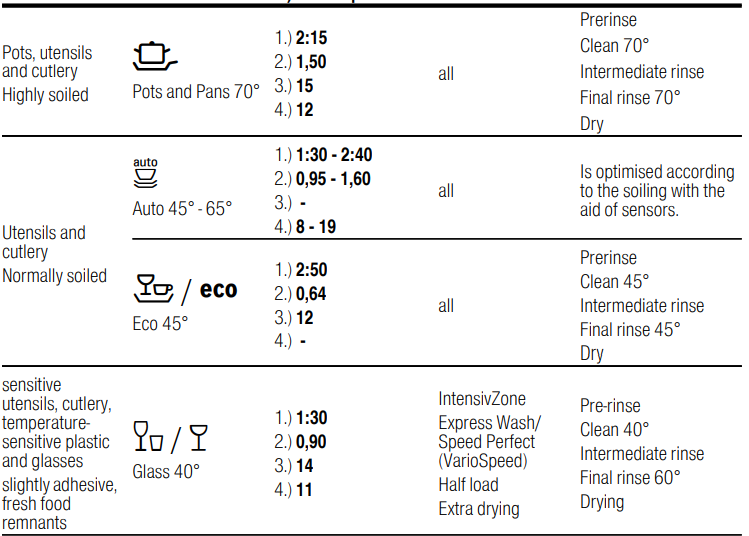
Additional options
Perfect/ (VarioSpeed) *
- This function can reduce the running time by approx. 20% to 50% depending on the selected rinse programme.
- The change in the running time is indicated on the digital display )". To obtain optimum cleaning results at a reduced running time, water and energy consumption are increased.
Half load
- If you have only a few items to wash e.g. glasses, cups, plates), you can switch to “half load”. This will save water, energy and time. It is recommended to put a little less detergent in the detergent dispenser than for a full load.
HygienePlus
- *HygienePlus This function increases the temperatures and retains them for an extra long time to obtain a defined disinfection performance. Continuous use of this function increases the hygiene status.
- This additional option is ideal for cleaning e.g. chopping boards and baby bottles.
Intensive zone
- *Intensive zone Perfect for a mixed load. You can wash very soiled pots and pans in the lower basket together with normally soiled utensils in the upper basket.
- The spray pressure in the lower basket is intensified, the rinsing temperature is increased slightly.
Extra drying
- *Extra drying An increased temperature during the final rinse and an extended drying phase ensure that even plastic parts dry better. There is a slight increase in the energy consumption.
Operating the appliance
Aqua sensorAqua sensor * depending on model
- The Aqua sensor is an optical measuring device (light barrier) which measures the turbidity of the rinsing water.
- The Aqua sensor is used according to the programme. If the Aqua sensor is active, “clean” rinsing water can be transferred to the next rinse bath and water consumption can be reduced by litres.
- If the turbidity is greater, the water is drained and is replaced with fresh water. In the automatic programmes the temperature and running time can also be adjusted to the degree of soiling.
Switching on the appliance
- Turn on the tap fully.
- Switch on ON/OFF switch
- The display of the last selected programme flashes. This programme remains selected if no other programme button 0 is pressed.
- The expected programme duration flashes on the digital display )".
- Press the START button `.
The programme starts running.
- Programme sequence indicatorProgramme sequence indicator h
- Remaining running time display
- When the programme is selected, the remaining running time of the programme is indicated on the digital display )".
- The running time is determined during the programme by the water temperature, the number of utensils as well as the degree of soiling and may vary (depending on the selected programme).
- Timer programmingTimer programming * depending on model
- You can delay the start of the programme in 1-hour steps up to hours.
Close the door.
- Switch on ON/OFF switch (.
- Press button P + until the digital display )" jumps to œ:‹‚.
- Press P + or – button until the displayed time corresponds with your requirements.
- Press START button `, timer programming is activated.
- To delete timer programming, press the P + or – button until )" œ:‹‹ is indicated on the digital display.
- You can change your programme selection at any time until the programme starts.
- Automatic switch off after end of programme or interior light*Automatic switch off / interior light depending on model
- To save energy, the dishwasher can be automatically switched off 1 min or 120 min after the programme ends.
- The setting can be selected from ˜:‹‹ to ˜:‹ƒ.
To change the setting:
- Press programme button 3.
- Each time the button is pressed, the set value increases by one level; when the value of ˜:‹ƒ has been reached, the display jumps back to ˜:‹‹.
- Press START button `.
- The set value is saved.
- Switching off the appliance
- Short time after the end of the programme:
- Switch off ON/OFF switch (.
- Turn off the tap (not applicable if
- Aqua-Stop fitted).
- Open the door.
- Remove the utensils when they have cooled down.
Note
- When the programme ends, leave the appliance to cool down a while before opening it. This will prevent steam from escaping and causing longterm damage to your built-in furniture.
- Interrupting the programme
Switch off ON/OFF switch .
- The LEDs go out. The programme is saved.
- If the door was opened on an appliance which has a warm water connection or is heated, first leave the door ajar for several minutes and then close. Otherwise, expansion pressure) may cause the appliance door to spring open or water to run out of the appliance.
- To continue the programme, switch on the ON/OFF switch ( again.
Terminating the programme Reset
- Press START button ` for approx. 3 sec.
- The numerical display )" indicates ‹:‹‚.
- The programme sequence lasts approx. 1 min. On the digital display )" is indicated ‹:‹‹.
- Switch off ON/OFF switch (.
- Changing the programme
- When the START button ` has been pressed, the programme cannot be changed.
- The only way a programme can be changed is by Cancel programme
Intensive drying
- The final rinse uses a higher temperature which improves the drying result. The running time may increase slightly. (Caution if utensils are delicate!)
- Close the door.
- Switch on ON/OFF switch (.
- Hold down programme button # and press START button ` until the digital display )" š:‹... is indicated.
- Release both buttons.
- To change the setting:
- Press the button 3 to switch the
- Intensive drying on š:‹‚ or off š:‹‹.
- Press START button `.
- The set value is saved.
Cleaning and maintenance
Overall condition of the machine
- Check spray arm for grease and limescale deposits.
- If you find such deposits:
- Fill detergent dispenser with detergent. Start the appliance without utensils in the programme with the highest rinsing temperature.
- Clean the appliance with detergents/ appliance cleaners which are particularly suitable for use with dishwashers.
- To ensure that the door seal always remains clean and hygienic, regularly clean it with a damp cloth and a little washing-up liquid.
- If the appliance is switched off for a prolonged period, leave the door ajar to prevent the formation of an unpleasant odour.
- Never use a steam cleaner to clean your dishwasher. The manufacturer is not liable for any consequential damage.
- Regularly wipe the front of the appliance and fascia with a damp cloth; water and a little washing up liquid are adequate. Do not use sponges with a rough surface or abrasive detergents, as these could scratch the surfaces.
- Stainless steel appliances: To prevent corrosion, avoid using sponge cloths or wash them out thoroughly several times before using for the first time.
Filters
- The filters 1R keep large foreign objects in the rinsing water away from the pump. These foreign objects may occasionally block the filters.
- The filter system consists of a coarse filter, a flat fine filter and a microfilter.
- After each washing cycle check the filters for residue.
- Unscrew filter cylinder as illustrated and take out filter system.

Fault, what to do?
- Experience has shown that you can rectify most faults which occur in daily operation yourself. This ensures that the machine is quickly available to you again.
- In the following overview you can find possible causes of malfunctions and helpful information for rectifying them.
Note
- If the appliance stops during dishwashing or does not start for no obvious reason, first run the Abort programme function (Reset).
- See chapter entitled “Operating the appliance”) m Warning – Don’t forget: Repairs may be carried out by technicians only. If a component has to be replaced, ensure that only original spare parts are used.
- Improper repairs or use of non-original spare parts may cause considerable damage and put the user at considerable risk.
Waste water pump
- Large food remnants or foreign objects which were not captured by the filters may block the waste water pump. The rinsing water will then be above the filter. m Warning – Risk of cuts!
- When cleaning the waste water pump, ensure that you do not injure yourself on pieces of broken glass or pointed implements.
In this case:
- First always disconnect the appliance from the power supply.
- Take out top basket 12 and bottom basket 1b.
- Remove the filters 1R.
- Scoop out water, use a sponge if required.
- Prise out the white pump cover as illustrated) using a spoon. Grip the cover on the crosspiece and lift diagonally inwards. Remove cover completely.
- Check impeller wheel and remove any foreign objects.
- Place cover in the original position and press down until it engages click).
- Install filters.
- Re-insert baskets.
Fault table
“Check water supply” display 8 lights up.
- Supply hose kinked
- Tap turned off.
- Tap jammed or calcified.
- Filter in the water supply blocked
- Install supply hose without kinks.
- Turn on the tap
- Turn on the tap. Tap jammed or calcified. Turn on the tap. Flow rate must be min. 10 l/min. when water supply is open
- Switch off the appliance and pull out the mains plug. Turn off the tap. Unscrew water connection.
A different error code is indicated on the digital display.
- A technical fault has probably occurred.
- Switch off appliances with the ON/OFF switch
- After a short time restart the appliance. If the problem recurs, turn off the tap and pull out the mains plug. Call customer service and mention the error code.
Display flashes
- Door not closed properly.
- Close the door.
- Ensure that no objects (utensil, fragrance dispenser) are protruding over the basket and preventing the door from closing
Refill indicator for rinse-aid @ is lit.
- No rinse aid.
- Refill rinse aid.
Refill indicator for rinse-aid @ is not lit.
- Refill indicator switched off.
- There is still enough rinse aid available.
- Activation/deactivation (see chapter Rinse aid).
- Check refill indicator, level.
Water is left in the appliance at the end of the programme.
- Filter system or area under the filters 1R is blocked.
- The programme has not yet ended.
- Clean filters and area underneath (see Waste water pump).
- Wait until programme ends or reset (see Terminating the programme).
Utensils not dry.
- Utensils not dry. No or too little rinse aid in the dispenser.
- Refill rinse aid.
- Programme selected without drying.
- Select programme with drying (see
- Overview of programmes, Programme sequence).
- Water collecting in depressions on the utensils and cutlery.
- Arrange utensils in a sloping position, arrange affected utensils as sloping as possible.
- The combined detergent used has a poor drying performance.
- Use different combination detergent with better drying performance. Use of rinse aid also increases the drying performance.
Intensive drying to increase drying not activated.
- Activate intensive drying (see Operating the appliance)
- Utensils were removed too early or drying process had not ended yet.
- Wait until program ends or wait until 30 min after program ends before removing utensils.
- The eco rinse aid used has a poor drying performance.
- Use a proprietary rinse aid. Eco products are much less effective.
- Plastic utensils not dry. Special properties of plastic. Plastic has a lower heat storage capacity and therefore dries less well.
Cutlery not dry.
- Cutlery not arranged properly in the cutlery basket.
- Separate cutlery if possible, prevent contact points.
- Cutlery not arranged properly in the cutlery drawer.
- Arrange cutlery properly and separate if possible.
- Appliance interior wet after rinse cycle.
No appliance fault.
- On account of the “Condensation drying” principle, water droplets are physically induced and required in the container.
- The humidity in the air condenses on the inner walls of the dishwasher, drains and is pumped out.
Food remnants on the utensils.
- Utensils placed too closely together, utensils basket overfilled.
- Arrange utensils with adequate clearance between them ensuring that the spray jets can reach the surface of the utensils.
Prevent contact points.
- Spray arm rotation obstructed.
- Arrange utensils so that the spray arm can rotate without obstruction.
- Spray arm nozzles blocked.
- Clean the spray arm nozzles,
Filters 1R dirty.
- Clean filters, (see Cleaning and maintenance).
- Filters 1R inserted incorrectly and/or not engaged.
Insert and engage filters correctly.
- Rinse programme too weak.
- Select a more intensive rinse programme.
- Utensils precleaned too intensely; sensors therefore decide on weak programme sequence.
- Stubborn soiling cannot be completely removed.
- Do not prerinse utensils. Remove only large food remnants.
- Tall narrow receptacles in corner areas are not rinsed adequately.
- Do not place hollow receptacles too obliquely and do not place in the corner area.
- Top basket 12 on right and left not set to same height.
Set top basket to same height using side levers.
- Detergent residue
- Detergent dispenser cover blocked by utensils and therefore does not open fully.
- Detergent dispenser cover must not be obstructed by utensils.
- Do not place utensils or fragrance dispenser in the tablet collecting tray.
- Detergent dispenser cover blocked by the tablet.
- Tablet must be inserted flat and not upright.
- Tablets used in the quick or short programme.
- Dissolving time of the detergent is not reached in the selected short programme.
- Dissolving time of tablets too long for a quick or short programme.
Use a detergent powder or select a more intensive programme.
- Washing effect and dissolving performance are reduced after a prolonged storage time or detergent is very lumpy.
- Change detergent.
- Water stains on plastic parts
- Droplet formation on plastic surface is physically unavoidable.
After drying, water stains are visible.
- Use a more intensive programme (more water changes).
- Arrange utensils in a sloping position.
Use rinse aid.
- Washable or water-soluble coatings in the container or on the door.
- Detergent substances are deposited. These coatings cannot usually be removed with chemicals (appliance cleaner, ...).
- Change detergent brand.
- Clean appliance mechanically.
- Only for glasses: Initial glass corrosion – can only apparently be wiped off.
See Glass and utensil damage.
- White, stubborn coatings; limescale on the utensils, container or door.
- Detergent substances are deposited. These coatings cannot usually be removed with chemicals (appliance cleaner, ...).
- Change detergent brand.
- Clean appliance mechanically.
- Underdosing of detergent. Increase detergent dosage or change detergent.
Too weak rinse programme selected.
- Select a more intensive rinse programme.
- Tea or lipstick residue on the utensils.
- Too low rinsing temperature. Select programme with higher washing temperature.
- Too little or unsuitable detergent. Use suitable detergent at correct dosage.
- Utensils precleaned too intensely; sensors therefore decide on weak programme sequence.
Stubborn soiling cannot be completely removed.
- Do not prerinse utensils. Remove only large food remnants.
- Coloured (blue, yellow, brown), difficult to remove to non-removable coatings in the appliance or on stainless steel utensils.
- Film formation consisting of ingredients from vegetables e.g. cabbage, celery, potatoes, noodles, ...) or the tap water (e.g. manganese).
- Can be partly removed with machine cleaner or by mechanical cleaning. Coatings are harmless.
- Film formation caused by metallic components on silver or aluminium utensils.
- Can be partly removed with machine cleaner or by mechanical cleaning.
- Plastic parts discoloured. Too low rinsing temperature. Select programme with higher washing temperature.
- Utensils precleaned too intensely; sensors therefore decide on weak programme sequence.
Stubborn soiling cannot be completely removed.
- Do not prerinse uten
- Removable streaks on glasses, glasses with metallic appearance and cutlery.
- Too much rinse aid. Set rinse aid amount to lower setting.
No rinse aid added or setting too low.
- Add rinse aid and check dosage recommended setting 4-5).
- Detergent residue in the final rinse programme section.
- Detergent dispenser cover blocked by utensils (cover does not open fully).
- Detergent dispenser cover must not be obstructed by utensils.
- Do not place utensils or fragrance dispenser in the tablet collecting tray.
- Utensils precleaned too intensely; sensors therefore decide on weak programme sequence.
- Stubborn soiling cannot be completely removed.
- Do not prerinse utensils. Remove only large food remnants.
Initial or existing, irreversible clouding of glass.
- Glasses not dishwasher-proof, only suitable for dishwasher.
- Use dishwasher-proof glasses.
- Avoid long steam phase (standing time after wash cycle ends).
- Use wash cycle at lower temperature.
- Use detergent with glass protection component.
- Rust spots on the cutlery. Cutlery not adequately rustresistant. Knife blades are frequently more severely affected.
Use corrosion-resistant cutlery.
- Cutlery will also rust if rusting parts are rinsed at the same time pan handles, damaged utensil baskets, etc.).
- Do not wash rusting parts.
- The appliance does not start.
- The mains fuse has tripped. Check mains fuse.
- Power cord not inserted. Ensure that the power cord is plugged all the way into the back of the appliance and into the socket. Check that the socket functions.
- The appliance door has not been shut properly.
Close the door.
- Programme starts automatically.
- You did not wait until programme ended.
- Perform reset.
The door is difficult to open.
- Child-proof lock is activated.
- Deactivate childproof lock. (See instructions for use at the back)
- Door cannot be closed.
- Door lock has been activated. Close door with increased force.
- Door cannot be closed due to installation.
- Check appliance installation: Door or attached parts must close without obstruction.
See other models: KIN34P60AU KDN53VW30A WTH83000GB/04 KUR15A65/02 HLN39A050U/07
